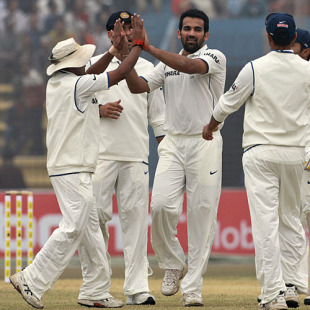What do you do when the curator has it in for bowlers? You plan, persevere and pray
July 29, 2010

| ||
| Related Links | ||
The tracks laid out for the first two Test matches in the ongoing Sri Lanka-India series have pretty much dictated the course of the matches. The Sri Lankan tracks, like most in the subcontinent, are batting havens - classic "win-the-toss-bat-first" surfaces, which in most cases push the team losing the toss into playing catch up for the duration of the match.
On these featherbeds the ball refuses to change its path after pitching, for spinners and fast bowlers alike, and the odds are stacked heavily against the bowlers and the fielding side. Yet there's a job to be done - to dismiss the opposition, failing which you need to brace yourself for a dreadfully long haul. Nothing hurts a player more than the feeling of helplessness against the inevitable, which in this case is the declaration from the batting side.
Does this mean one resigns to fate and does not plan at all? Definitely not. In fact, bowling on such tracks might need more planning than on helpful surfaces. But planning alone is often not enough; it needs to be complemented with lots of perseverance.
Fast bowlers with the new ball
A fast bowler's planning depends on the ball being used in the match. If the match is in India, it is the SG Test ball that is used, which of course behaves quite differently to the Kookaburra.
The SG ball moves negligibly in the air while it's new, and so it's important to hit the deck hard till one side gets rough. You often see Zaheer Khan bowl cross-seam deliveries right at the beginning of a spell to hasten this process. And I vividly remember Glenn McGrath employing similar tactics in the 2004 series in India.
Unless the team has three seamers at their disposal, it isn't a bad idea to hold back the two frontline quicks till one side of the ball loses its sheen. A part-time quick or a spinner comes handy in these conditions. This was the job Angelo Mathews did for Sri Lanka in India last year.
Once the ball starts swinging, releasing it right, instead of hitting the deck hard, becomes the mantra. The track might not offer lateral movement but the ball will likely swing in the air, if delivered properly. Since the swing in the air may not be complemented by movement off the surface, field placements may still need to be a little conservative. The bowlers must stick to a line, set their fields accordingly and err only on the side of fullness, for balls pitched short won't even move in the air.
Bowlers must employ different tactics while bowling with the Kookaburra, which, unlike the SG ball, moves appreciably when it's new. Hence the endeavour should be to release the ball properly, pitch it slightly fuller and extract movement in the air. Smart bowlers use the more pronounced seam to bowl cutters too.
Lasith Malinga did something remarkable in the first Test match, in Galle. He bowled fuller to start with, dismissed Gautam Gambhir cheaply in both innings, and then used the hardness of the ball to push Virender Sehwag on to the back foot with a barrage of well-directed bouncers when he saw there wasn't much swing on offer. He knew that once the ball lost its hardness, he would have to wait for it to start reverse-swinging to inflict damage. The trick is to assess the conditions quickly and then react appropriately, be it the SG Test or the Kookaburra ball.
Fast bowlers when the ball gets old
The brand of ball makes very little difference in the approach when the ball gets old, when there isn't much conventional swing, no movement off the surface, and it's too early to get reverse swing going. That's when discipline and patience take centre stage.
| The brand of ball makes very little difference in the approach when the ball gets old, when there isn't much conventional swing, no movement off the surface, and it's too early to get reverse swing going. That's when discipline and patience take centre stage | |||
Zaheer is a master operator in these situations, especially in post-lunch sessions in the subcontinent. He bowls at about 70% of his optimum speed, sticks to a line a foot outside off stump, employs a 6-3 or 7-2 off-side field and waits for the batsman to commit hara-kiri. He has the advantage of the natural angle working for him, taking the ball away from the right-hander even when it isn't swinging.
Another tactic, if executed well, is to accept that there isn't enough movement to find the outside edge, and that even if you do, it's unlikely to carry to the slips. Then one must bowl wicket to wicket, keep the catching fielders in front of the stumps and hope to either breach the defence or expect the batsman to get carried away and hit in the air. You need to be persistent rather than imaginative to see through such phases. But consistency in line and length is imperative, else you'll be punished, for the margin of error is really small. The only thing you must constantly vary is the pace. Rolling your fingers over the ball to bowl slower ones and cutters are among the few ways to create doubt in the batsman's mind in these conditions.
Another tactic is to get two fast bowlers to bowl bouncers in tandem from around the stumps, with both fine leg and square leg on the fence. Since there's nothing happening otherwise, there's no harm in trying something different.
Once the ball starts reverse-swinging, good quick bowlers come into their own. One is still required to stick to a line (you don't want to bowl on both sides of the wicket) but lengths can, and perhaps must, vary with almost every delivery. The last thing you, as a bowler, want when the ball is reverse-swinging is to be predictable. Even a toe-crushing yorker doesn't have the same effect if every ball is in the block-hole.
Once again, Malinga used the old ball quite effectively in the first Test match to break the back of the Indian batting line-up, dismissing Rahul Dravid, Sachin Tendulkar and MS Dhoni. Michael Kasprowicz did something similar in the series against India in 2004. He was so ruthless with his lines around the middle and leg stumps that he could do without a slip or a gully fielder.
While talking about masters with the old ball, it would be criminal not to mention Waqar and Wasim. But these two were special bowlers with special skills and others can only dream of emulating them. Don't they say: planning and plotting is for lesser mortals; geniuses carve their own road.
Spinners
Slow bowlers are your workhorses on dead surfaces, for good captains rarely give their fast bowlers long spells. Spinners are required to do the donkey's work of bowling extremely long spells with or, mostly, without any assistance from the surface. They need strategies too, but unlike for their quicker counterparts, their plans don't vary from Kookaburra to SG Test, for balls don't behave radically differently depending on their brand when in the hands of a spinner.

| ||
| | ||
Length is not negotiable: they must stick to it for as long as they are bowling or pay for it dearly. The lines and the pace, though, must keep changing, along with the introduction of variations like the doosra, googly or the arm ball.
The lack of purchase from the surface, unless you're a Murali or Warne, might make a spinner monotonous, and that's what they must guard against. They must keep using the drift, experiment with angles by coming over and around the stumps, and use fielders cleverly to play with the batsman's mind. There may be nothing happening but the batsman must always get the impression that there's a plan in place. And the most likely way for a spinner to get a wicket on these surfaces is to put pressure on the batsman by making run-scoring difficult and thus making him commit a faux pas.
I really like how Daniel Vettori operates on good surfaces against quality players of spin bowling. He tries to block their working areas - i.e. behind square leg for a left-hander and point for a right-hander - by altering his line and length and placing a fielder to cut off the single. By doing so he challenges the batsman to do something different, like go over the top or play against the spin. He may not always be successful, though he mostly is, but his intentions are absolutely right.
In batting-friendly conditions it helps to have a multi-dimensional attack: a couple of attacking bowlers who're expected to go for wickets, though they might be a little expensive in the bargain, along with a couple of defensive bowlers who'll stem the flow of runs and also give their more aggressive counterparts some respite.
Ideally one would always have tracks like the ones England dished out for the recently concluded Pakistan-Australia Test series, which had enough in them to keep the bowlers interested. But expecting them from curators in the subcontinent would be a bit too optimistic. While I have written about how a bowler can plan, it's still a bloody tough job to be a bowler in the subcontinent. Unless we make a conscious effort to prepare sporting wickets, it may well cut a few careers short, either due to injury or lack of results. To those who're still standing and delivering in these inhuman conditions: take a bow!
No comments:
Post a Comment